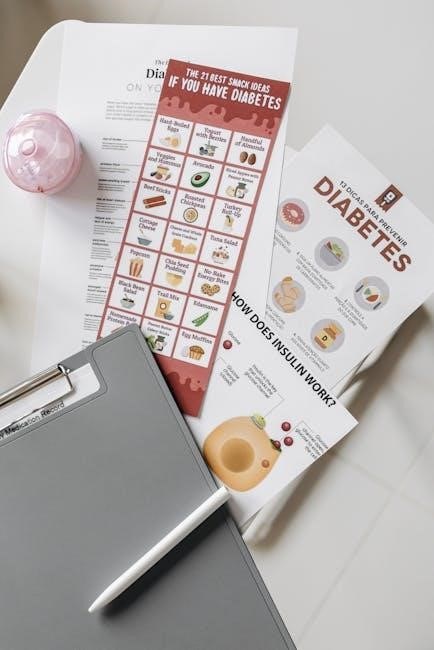Lancets are essential for blood glucose monitoring with the Accu-Chek Guide system, offering precise and comfortable testing. The Softclix lancing system features 11 depth settings and thin, bevel-cut lancets for smoother entry, reducing discomfort during blood sampling. Designed for compatibility with the Accu-Chek Guide, these sterile lancets ensure accurate and hygienic testing, making them a crucial component of daily diabetes management.

Overview of the Accu-Chek Guide System
The Accu-Chek Guide System is a comprehensive blood glucose monitoring solution designed for simplicity, accuracy, and comfort. It includes the Accu-Chek Guide meter, test strips, and the Softclix lancing device. The system is known for its ease of use, portability, and advanced features like smartphone integration via the mySugr app. The meter offers accurate readings, and the test strips are cost-effective, making it a practical choice for daily diabetes management. The Softclix lancing device, with its 11 depth settings and thin, bevel-cut lancets, ensures a more comfortable testing experience. Together, these components provide a seamless and user-friendly approach to monitoring blood glucose levels, helping individuals manage their diabetes effectively.
Importance of Lancets in Blood Glucose Monitoring
Lancets are vital for obtaining accurate blood samples, essential for reliable blood glucose readings. They ensure precise and hygienic testing, minimizing discomfort and infection risks. Using high-quality lancets like those designed for the Accu-Chek Guide system is crucial for maintaining testing consistency and overall diabetes management. Regular use of sterile lancets helps prevent contamination and ensures accurate results, which are critical for making informed health decisions. Proper lancing technique, supported by compatible lancets, enhances comfort and reduces the risk of complications, making lancets an indispensable tool in daily glucose monitoring routines.

Understanding Lancets
Lancets are small, sterile devices used to obtain blood samples for glucose monitoring. They feature thin gauges and bevel-cut tips for smoother entry, reducing discomfort during testing.
What Are Lancets and Their Purpose
Lancets are small, sterile devices used to prick the skin and draw a small blood sample for glucose monitoring. Their primary purpose is to enable precise and comfortable blood sampling, essential for managing diabetes. Designed with thin gauges and bevel-cut tips, lancets minimize discomfort during testing. The Accu-Chek Guide system uses lancets compatible with the Softclix lancing device, which features 11 depth settings for personalized comfort. Lancets are crucial for obtaining accurate blood samples, ensuring reliable glucose readings. They are designed to be safe, hygienic, and easy to use, making them an indispensable tool for daily diabetes care.
Types of Lancets Compatible with Accu-Chek Guide
The Accu-Chek Guide system is designed to work with specific lancets, such as the Accu-Chek Softclix and FastClix lancets. These lancets are engineered for optimal performance and comfort. The Softclix lancets feature a thin 30-gauge design with a bevel-cut tip, ensuring smoother skin entry and reduced discomfort. They are pre-sterilized and individually wrapped for convenience and hygiene. The FastClix lancets are part of a drum system, offering multiple lancets in one device, which simplifies the process of testing and reduces the need for frequent changes. Both types are specifically designed for use with the Accu-Chek Guide lancing device, ensuring compatibility and reliable blood glucose monitoring. These lancets are tailored to meet the needs of individuals with diabetes, providing accurate and comfortable testing experiences.
Key Features of Accu-Chek Lancets
Accu-Chek lancets are designed for comfort and accuracy, featuring a thin 30-gauge design with a bevel-cut tip for smoother skin entry. They are pre-sterilized and individually wrapped to ensure hygiene and convenience. The Softclix lancets are part of a system with 11 depth settings, allowing users to customize their testing experience. Additionally, the precision-guided technology minimizes discomfort and ensures precise lancing. These lancets are compatible with the Accu-Chek Softclix lancing device, making blood glucose monitoring easier and more efficient. Their ergonomic design and advanced features make them a reliable choice for daily diabetes management, providing both accuracy and comfort for users.

The Accu-Chek Guide Lancing System
The Accu-Chek Guide Lancing System offers a comfortable and precise way to collect blood samples. With 11 depth settings and precision-guided technology, it ensures easier and more accurate testing.
Overview of the Accu-Chek Guide Lancing Device
The Accu-Chek Guide Lancing Device is designed for comfort and precision, featuring 11 adjustable depth settings to customize the lancing experience. It uses the Softclix technology, which ensures a smooth and gentle entry with minimal discomfort. The device is compatible with Accu-Chek Guide lancets, which are sterile, thin-gauge, and bevel-cut for easier penetration. Its ergonomic design makes it easy to handle, allowing users to test from alternative sites like the forearm or palm. The lancing device is an integral part of the Accu-Chek Guide system, providing accurate and reliable blood glucose monitoring. It is engineered to reduce pain and simplify the testing process for people with diabetes.
How to Use the Softclix Lancing System
Using the Softclix Lancing System is straightforward and designed for comfort. First, insert a sterile lancet into the device, ensuring it clicks securely. Next, set the depth setting based on your skin type and comfort preference using the 11 adjustable options. Place the device firmly against your fingertip or alternative testing site, such as the forearm or palm. Gently press the lancing button to activate the precision-guided mechanism, which ensures a smooth and controlled puncture. The thin, bevel-cut lancet minimizes discomfort during entry. After testing, remove the used lancet and store it safely. Regularly changing lancets is recommended for hygiene and accuracy, though some users report reusing them for extended periods. Always follow proper safety precautions to avoid infections.
Benefits of the Softclix Precision Guided Technology
The Softclix Precision Guided Technology offers enhanced comfort and accuracy for blood glucose testing. Its 11 depth settings allow personalized comfort, catering to different skin types and sensitivity levels. The thin, bevel-cut lancets ensure a smoother entry, reducing discomfort and making testing less painful. The precision-guided mechanism delivers consistent results, minimizing the risk of inaccurate blood samples. This technology also promotes hygiene by using sterile, single-use lancets, reducing the risk of infections. Additionally, the system is designed for ease of use, with a simple and intuitive design that makes testing straightforward for users of all ages. Overall, the Softclix Precision Guided Technology combines comfort, accuracy, and convenience, making it an ideal choice for daily blood glucose monitoring.

Choosing the Right Lancets
Selecting the right lancets ensures comfort and accuracy. Opt for sterile, thin-gauge lancets with bevel-cut tips for smoother entry. Compatibility with your Accu-Chek device is crucial for optimal performance.
Factors to Consider When Selecting Lancets
When selecting lancets for the Accu-Chek Guide, consider factors like comfort, compatibility, and ease of use. Depth settings and gauge are critical for minimizing discomfort, with thinner gauges (e.g., 30-gauge) causing less pain. Ensure lancets are sterile and designed for your device to maintain accuracy. Compatibility is key, as not all lancets work with the Accu-Chek Guide. Additionally, consider cost-effectiveness and user reviews to assess satisfaction. Proper storage and disposal are also important for safety. By evaluating these factors, you can choose lancets that meet your needs for effective blood glucose monitoring.
Understanding Lancet Gauge and Depth Settings
Lancet gauge refers to the thickness of the needle, with lower numbers indicating thicker needles and higher numbers indicating thinner ones. The Accu-Chek Guide uses 30-gauge lancets, which are thin and designed for minimal discomfort. Depth settings determine how deeply the lancet penetrates the skin, with adjustable options to suit individual preferences. The Softclix system offers 11 depth settings, allowing users to customize their testing experience for comfort and accuracy. Proper gauge and depth settings help ensure effective blood sample collection while minimizing pain, making them crucial for regular blood glucose monitoring. Understanding these features helps users optimize their testing routine for better results and comfort.
How to Ensure Compatibility with Accu-Chek Devices
To ensure compatibility with Accu-Chek devices, always use lancets specifically designed for your meter, such as the Accu-Chek Softclix or FastClix lancets. Check the product packaging or user manual for compatibility confirmation. Using non-compatible lancets may result in inaccurate blood glucose readings or device malfunctions. The Accu-Chek Guide system is optimized for use with its own lancets, ensuring precise and comfortable testing. For optimal performance, avoid mixing lancets from other brands. Consult Roche Diabetes Care’s official website or contact customer support for confirmation if unsure. Proper compatibility ensures accurate results, device longevity, and a better testing experience.

Using Lancets with the Accu-Chek Guide
Using Accu-Chek Guide lancets is straightforward, thanks to the Softclix system’s 11 depth settings and precision-guided technology, ensuring smooth entry and reduced discomfort during blood glucose testing.
Step-by-Step Guide to Using Lancets
Using lancets with the Accu-Chek Guide is a simple process that ensures accurate and comfortable blood glucose testing. Start by washing and drying your hands. Choose a clean, dry lancet and insert it into the Softclix lancing device, ensuring it clicks securely. Set the depth setting based on your skin type and comfort preference. Place the lancing device against your fingertip or alternative site, such as the forearm. Press the device firmly to trigger the lancet, creating a small puncture. Gently squeeze your finger to collect a blood sample. Once enough blood appears, apply it to the Accu-Chek Guide test strip for an accurate reading. Proper technique minimizes discomfort and ensures reliable results.
Best Practices for Lancing Technique
Proper lancing technique is crucial for accurate and comfortable blood glucose testing. Always use a new, sterile lancet for each test to prevent infection and ensure sharpness. Choose the correct depth setting on your Softclix device based on your skin type and comfort level. To minimize discomfort, lancet at the side of your fingertip rather than the center, as this area is less sensitive. You can also use alternative testing sites, such as the forearm or palm, for added comfort. Keep your hand steady and press the lancing device firmly to ensure a quick, precise puncture. Avoid squeezing too hard, as this can cause bruising or pain. Proper technique helps maintain accuracy and reduces discomfort during testing.
How to Minimize Discomfort During Testing

To minimize discomfort while using Accu-Chek Guide lancets, choose the correct depth setting on your Softclix device based on your skin thickness. Using a new, sterile lancet each time ensures sharpness and prevents dullness, which can cause more pain. The Softclix system’s thin, bevel-cut lancets are designed for smoother entry and reduced discomfort. Additionally, testing on alternative sites, such as the forearm or palm, can be less painful than fingertip testing. Keep your skin relaxed and avoid squeezing too hard, as this can increase pressure and discomfort. By following these steps, you can make blood glucose testing more comfortable and stress-free while maintaining accuracy.
Maintenance and Safety
Properly store lancets in a cool, dry place and dispose of used ones safely. Always use sterile lancets to prevent infections and ensure accurate testing results.
When to Change Lancets
Changing lancets regularly is crucial for maintaining hygiene and ensuring accurate blood glucose readings. Lancets should be replaced after each use to prevent infection and avoid dulling, which can cause discomfort. While some users report using lancets for extended periods, it is recommended to change them frequently to maintain sterility and effectiveness. Signs that a lancet needs changing include increased pain during testing or visible wear. Proper disposal of used lancets in a puncture-proof container is also essential for safety. The Accu-Chek Guide system is designed for compatibility with sterile, thin-gauge lancets, ensuring smooth entry and minimal discomfort. Regularly changing lancets helps maintain the integrity of your testing routine and overall diabetes management.
Proper Storage and Disposal of Lancets
Proper storage and disposal of Accu-Chek Guide lancets are essential for safety and hygiene. Store lancets in a cool, dry place, away from direct sunlight and out of reach of children. Used lancets should be disposed of immediately after use to prevent accidental injury or infection. Use a puncture-proof container, such as a sharps disposal container, to safely discard used lancets. Do not recycle lancets or dispose of them in regular trash. Always follow local regulations for sharps disposal. Proper storage ensures lancets remain sterile and effective, while safe disposal protects others from potential harm. Regularly cleaning and maintaining your lancing device also supports overall hygiene and functionality.
Safety Precautions to Avoid Infections
To prevent infections when using Accu-Chek Guide lancets, always use a new, sterile lancet for each test. Never share lancets, as this can spread bacteria and viruses. Wash your hands thoroughly with soap and water before handling lancets or your lancing device. Ensure the lancing device is clean and free from contamination. After use, dispose of lancets safely in a puncture-proof container to avoid accidental needlestick injuries. Store lancets in a dry, cool place to maintain sterility. Regularly inspect lancets for damage or dullness, as these can increase the risk of infection. By following these precautions, you can ensure a safe and hygienic blood glucose testing process.

Troubleshooting Common Issues
Troubleshooting common issues with Accu-Chek Guide lancets involves resolving inaccurate readings, addressing device malfunctions, and minimizing discomfort. Ensure proper meter calibration, check for damaged lancets, and clean the device regularly.
Resolving Inaccurate Blood Glucose Readings
Inaccurate blood glucose readings with the Accu-Chek Guide can occur due to faulty lancets, improper device calibration, or damaged test strips. To resolve this, ensure the meter is calibrated correctly and use unexpired test strips. Check for any visible damage to the lancets or the lancing device, as dull or bent lancets can lead to insufficient blood samples. Additionally, verify that the lancet depth setting is appropriate for your skin type to avoid inadequate blood flow. If issues persist, consult the user manual or contact Accu-Chek customer support for assistance. Regular maintenance and proper storage of lancets and test strips can also help maintain accuracy.
By addressing these factors, you can ensure reliable blood glucose monitoring with the Accu-Chek Guide system.
Addressing Lancet Device Malfunctions
Lancet device malfunctions, such as jammed drums or misaligned parts, can disrupt blood glucose monitoring. If the Accu-Chek Guide lancing device fails to function properly, first ensure it is clean and free from debris. Check for worn-out or damaged lancets, as these can cause inconsistent performance. If the issue persists, consult the user manual for troubleshooting steps or replace the device if necessary. In some cases, recalibrating the device or using a new lancet drum may resolve the problem. For unresolved issues, contact Accu-Chek customer support for assistance or repair. Regular maintenance and proper storage of the lancing device can help prevent malfunctions and ensure reliable performance.
Addressing these issues promptly is crucial for accurate and consistent blood glucose monitoring.
What to Do If a Lancet Causes Excessive Pain
If a lancet causes excessive pain, it may be due to a dull or bent lancet, improper depth settings, or incorrect technique. Replace the lancet with a new, sterile one to ensure sharpness and hygiene. Adjust the depth setting on the lancing device to a shallower level to minimize discomfort. Consider using alternative testing sites, such as the forearm or palm, which may be less sensitive. Ensure proper lancing technique by holding the device at a 90-degree angle and using a quick, firm motion. If pain persists, consult a healthcare professional for guidance or explore other lancing devices designed for comfort, such as the Accu-Chek Softclix system with precision-guided technology.
Addressing pain promptly ensures a better testing experience and accurate results.
Comparing Accu-Chek Lancets to Other Brands
Accu-Chek lancets stand out with their precision-guided technology, thin gauge, and bevel-cut design, offering superior comfort and accuracy. Their compatibility with the Softclix device enhances user convenience and satisfaction.

Differences in Design and Comfort
Accu-Chek lancets are designed with a thin 30-gauge needle and a bevel-cut tip, ensuring smoother skin entry and reduced discomfort. The Softclix technology provides precise control over lancing depth, minimizing pain. Compared to other brands, Accu-Chek lancets are known for their ergonomic design and compatibility with the Softclix lancing device, which offers 11 adjustable depth settings. This adaptability makes them suitable for various skin types and sensitivity levels. Other brands may lack the precision-guided technology or the thin gauge, often resulting in a less comfortable testing experience. Accu-Chek’s focus on user comfort and innovative design sets them apart, making them a preferred choice for many diabetes patients seeking a more pleasant blood glucose monitoring process.
Cost-Effectiveness of Accu-Chek Lancets
Accu-Chek lancets are designed to balance quality and affordability, making them a cost-effective option for blood glucose monitoring. While prices may vary by region and insurance coverage, the lancets are generally priced competitively compared to other brands. The Softclix technology, with its pre-loaded lancet drums, reduces the need for frequent replacements, offering long-term savings. Additionally, the reusable lancing device and compatibility with the Accu-Chek Guide system ensure that users do not incur extra costs for separate devices. Overall, Accu-Chek lancets provide a reliable and economical solution for diabetes management, combining innovative design with budget-friendly options for users worldwide.
User Preferences and Satisfaction Ratings
Users consistently praise Accu-Chek lancets for their comfort and ease of use, with high satisfaction ratings across various reviews. Many appreciate the thin gauge and bevel-cut design, which minimizes discomfort during blood sampling. The Softclix system, with its pre-loaded lancet drums, is particularly favored for its convenience and reduced need for frequent lancet changes. Overall, users highlight the ergonomic design and compatibility with the Accu-Chek Guide as key factors contributing to their positive experience. While some note minor preferences for other brands, the majority agree that Accu-Chek lancets deliver reliable performance and comfort, making them a popular choice among diabetes patients.
Conclusion
The Accu-Chek Guide lancets offer accuracy, comfort, and ease of use, supported by positive user feedback, making them an excellent choice for effective blood glucose monitoring and diabetes management.
Summary of Key Points
The Accu-Chek Guide lancets are designed for comfort and accuracy, featuring thin gauges and bevel-cut tips to minimize discomfort during blood sampling. The Softclix lancing system offers 11 depth settings, allowing users to customize their testing experience. These lancets are specifically compatible with the Accu-Chek Guide and Softclix devices, ensuring reliable performance. Users appreciate the sterile design and ease of use, which supports effective blood glucose monitoring. Regular lancet changes are recommended to maintain hygiene and accuracy. Proper storage and disposal are essential to prevent infections. Overall, the Accu-Chek Guide lancets provide a balance of comfort, precision, and user satisfaction, making them a practical choice for diabetes management.
Final Tips for Effective Use of Lancets

For optimal use of Accu-Chek Guide lancets, always prioritize proper technique and hygiene. Use the Softclix lancing system with its 11 depth settings to customize comfort. Ensure lancets are sterile and replaced regularly to maintain accuracy and prevent infections. Experiment with different lancing sites, such as the forearm, to minimize discomfort. Store lancets in a cool, dry place and dispose of them safely. Avoid reusing lancets to ensure sharpness and hygiene. Adjust depth settings based on skin thickness for better comfort. Regularly clean and maintain the lancing device to ensure proper function. By following these tips, you can enhance your testing experience and manage diabetes more effectively.
